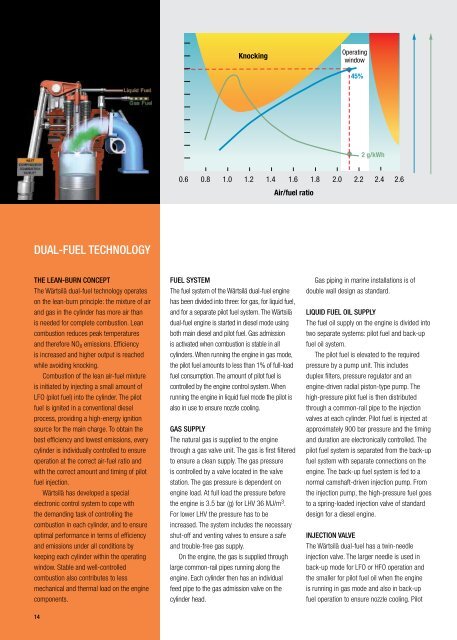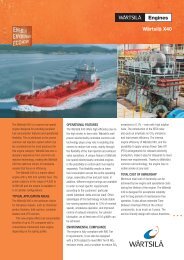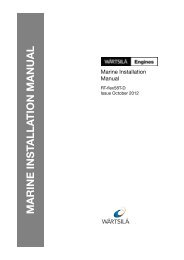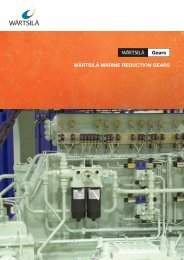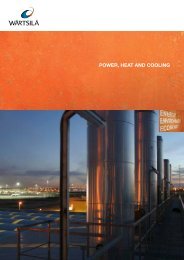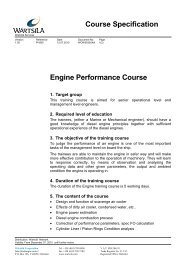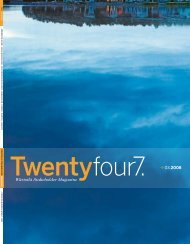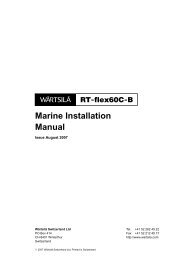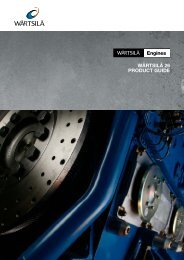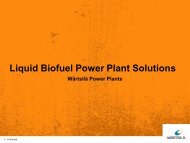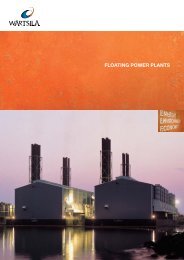Wärtsilä Medium-Speed Marine Diesel Engines
Wärtsilä Medium-Speed Marine Diesel Engines
Wärtsilä Medium-Speed Marine Diesel Engines
Create successful ePaper yourself
Turn your PDF publications into a flip-book with our unique Google optimized e-Paper software.
BMEP (bar)<br />
Knocking<br />
Operating<br />
window<br />
45%<br />
0.6 0.8 1.0 1.2 1.4 1.6 1.8 2.0 2.2<br />
Air/fuel ratio<br />
2 g/kWh<br />
2.4<br />
Misfiring<br />
2.6<br />
Thermal efficiency (%)<br />
NO (g/kWh)<br />
X<br />
DUAL-FUEL TECHNOLOGY<br />
THE LEAN-BURN CONCEPT<br />
The Wärtsilä dual-fuel technology operates<br />
on the lean-burn principle: the mixture of air<br />
and gas in the cylinder has more air than<br />
is needed for complete combustion. Lean<br />
combustion reduces peak temperatures<br />
and therefore NO X emissions. Efficiency<br />
is increased and higher output is reached<br />
while avoiding knocking.<br />
Combustion of the lean air-fuel mixture<br />
is initiated by injecting a small amount of<br />
LFO (pilot fuel) into the cylinder. The pilot<br />
fuel is ignited in a conventional diesel<br />
process, providing a high-energy ignition<br />
source for the main charge. To obtain the<br />
best efficiency and lowest emissions, every<br />
cylinder is individually controlled to ensure<br />
operation at the correct air-fuel ratio and<br />
with the correct amount and timing of pilot<br />
fuel injection.<br />
Wärtsilä has developed a special<br />
electronic control system to cope with<br />
the demanding task of controlling the<br />
combustion in each cylinder, and to ensure<br />
optimal performance in terms of efficiency<br />
and emissions under all conditions by<br />
keeping each cylinder within the operating<br />
window. Stable and well-controlled<br />
combustion also contributes to less<br />
mechanical and thermal load on the engine<br />
components.<br />
FUEL SYSTEM<br />
The fuel system of the Wärtsilä dual-fuel engine<br />
has been divided into three: for gas, for liquid fuel,<br />
and for a separate pilot fuel system. The Wärtsilä<br />
dual-fuel engine is started in diesel mode using<br />
both main diesel and pilot fuel. Gas admission<br />
is activated when combustion is stable in all<br />
cylinders. When running the engine in gas mode,<br />
the pilot fuel amounts to less than 1% of full-load<br />
fuel consumption. The amount of pilot fuel is<br />
controlled by the engine control system. When<br />
running the engine in liquid fuel mode the pilot is<br />
also in use to ensure nozzle cooling.<br />
GAS SUPPLY<br />
The natural gas is supplied to the engine<br />
through a gas valve unit. The gas is first filtered<br />
to ensure a clean supply. The gas pressure<br />
is controlled by a valve located in the valve<br />
station. The gas pressure is dependent on<br />
engine load. At full load the pressure before<br />
the engine is 3.5 bar (g) for LHV 36 MJ/m 3 .<br />
For lower LHV the pressure has to be<br />
increased. The system includes the necessary<br />
shut-off and venting valves to ensure a safe<br />
and trouble-free gas supply.<br />
On the engine, the gas is supplied through<br />
large common-rail pipes running along the<br />
engine. Each cylinder then has an individual<br />
feed pipe to the gas admission valve on the<br />
cylinder head.<br />
Gas piping in marine installations is of<br />
double wall design as standard.<br />
LIQUID FUEL OIL SUPPLY<br />
The fuel oil supply on the engine is divided into<br />
two separate systems: pilot fuel and back-up<br />
fuel oil system.<br />
The pilot fuel is elevated to the required<br />
pressure by a pump unit. This includes<br />
duplex filters, pressure regulator and an<br />
engine-driven radial piston-type pump. The<br />
high-pressure pilot fuel is then distributed<br />
through a common-rail pipe to the injection<br />
valves at each cylinder. Pilot fuel is injected at<br />
approximately 900 bar pressure and the timing<br />
and duration are electronically controlled. The<br />
pilot fuel system is separated from the back-up<br />
fuel system with separate connections on the<br />
engine. The back-up fuel system is fed to a<br />
normal camshaft-driven injection pump. From<br />
the injection pump, the high-pressure fuel goes<br />
to a spring-loaded injection valve of standard<br />
design for a diesel engine.<br />
INJECTION VALVE<br />
The Wärtsilä dual-fuel has a twin-needle<br />
injection valve. The larger needle is used in<br />
back-up mode for LFO or HFO operation and<br />
the smaller for pilot fuel oil when the engine<br />
is running in gas mode and also in back-up<br />
fuel operation to ensure nozzle cooling. Pilot<br />
14


